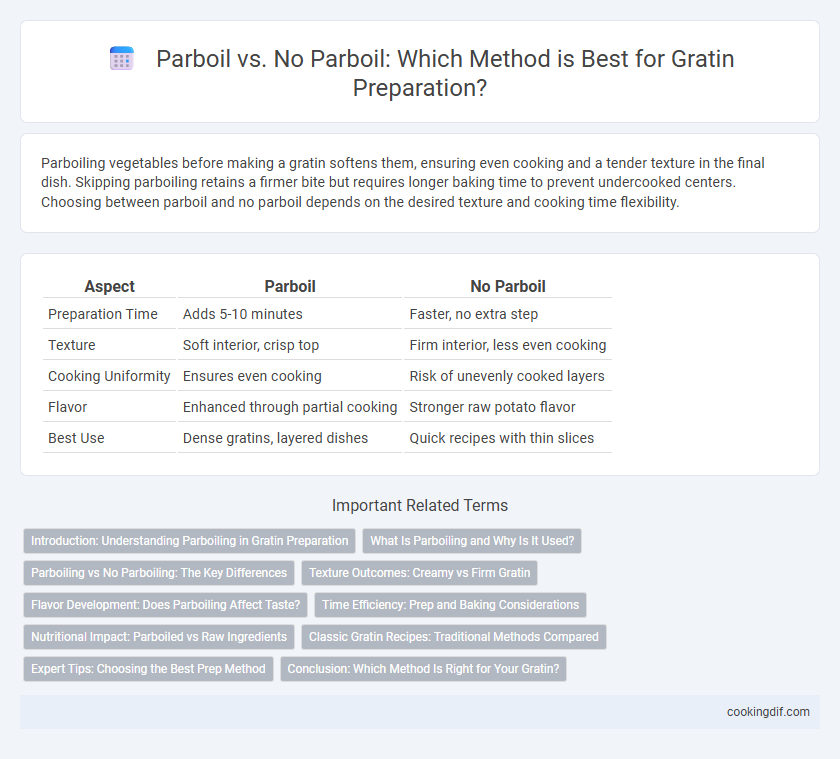Parboiling vegetables before making a gratin softens them, ensuring even cooking and a tender texture in the final dish. Skipping parboiling retains a firmer bite but requires longer baking time to prevent undercooked centers. Choosing between parboil and no parboil depends on the desired texture and cooking time flexibility.
Table of Comparison
| Aspect | Parboil | No Parboil |
|---|---|---|
| Preparation Time | Adds 5-10 minutes | Faster, no extra step |
| Texture | Soft interior, crisp top | Firm interior, less even cooking |
| Cooking Uniformity | Ensures even cooking | Risk of unevenly cooked layers |
| Flavor | Enhanced through partial cooking | Stronger raw potato flavor |
| Best Use | Dense gratins, layered dishes | Quick recipes with thin slices |
Introduction: Understanding Parboiling in Gratin Preparation
Parboiling vegetables before layering them in a gratin helps to soften and partially cook the ingredients, ensuring even texture and faster baking times. Skipping the parboil step may result in a gratin with crunchier, less uniformly cooked vegetables, which can affect the dish's overall consistency. Understanding when to parboil depends on the vegetable type and desired gratin texture, balancing preparation time and final flavor.
What Is Parboiling and Why Is It Used?
Parboiling involves partially boiling vegetables or potatoes before baking to soften them and reduce overall cooking time in gratin dishes. This technique helps achieve a tender interior while ensuring even cooking, preventing raw or undercooked textures in layered gratins. Skipping parboiling can result in unevenly cooked gratins with harder centers, especially when using denser ingredients like potatoes.
Parboiling vs No Parboiling: The Key Differences
Parboiling vegetables before making gratin softens them and ensures even cooking, resulting in a creamier texture and more uniform browning. Skipping the parboil step allows for more natural, firmer textures but may increase baking time and risk uneven doneness. Choosing parboiled ingredients optimizes flavor infusion, while no parboil preserves crispness and a rustic bite in the gratin.
Texture Outcomes: Creamy vs Firm Gratin
Parboiling potatoes before baking a gratin results in a creamier texture, as the partially cooked potatoes absorb cream and cheese more effectively. Skipping the parboil step retains a firmer bite, offering a more defined texture that holds its shape during baking. Choosing between parboil and no parboil depends on the desired balance between softness and structural integrity in the final gratin.
Flavor Development: Does Parboiling Affect Taste?
Parboiling vegetables for gratin can soften them quickly but may leach out natural sugars and nutrients, potentially reducing overall flavor intensity. Skipping parboiling preserves the vegetables' inherent taste and enhances caramelization during baking, leading to richer, more complex flavors. Therefore, avoiding parboiling often results in a gratin with bolder, more developed taste profiles.
Time Efficiency: Prep and Baking Considerations
Parboiling vegetables before gratin preparation significantly reduces baking time by partially cooking ingredients, which ensures even texture and faster overall cooking. Skipping parboiling can lead to longer baking durations and uneven doneness, particularly with dense vegetables like potatoes or carrots. Balancing preparation time and baking efficiency depends on the desired flavor development and texture precision in the final gratin dish.
Nutritional Impact: Parboiled vs Raw Ingredients
Parboiling vegetables for gratin can reduce nutrient loss by partially cooking and softening them, which preserves vitamins like vitamin C and folate compared to using raw ingredients that may require longer oven times leading to greater nutrient degradation. Parboiled potatoes retain more resistant starch and reduce phytic acid, enhancing mineral absorption while raw potatoes might cause uneven cooking and a higher glycemic index in the finished dish. Nutritional bioavailability improves with parboiled ingredients due to reduced cooking time, conserving heat-sensitive antioxidants and water-soluble vitamins essential for a healthier gratin.
Classic Gratin Recipes: Traditional Methods Compared
Parboiling potatoes in classic gratin recipes softens the slices, ensuring even cooking and a creamy texture, while skipping this step preserves a firmer bite and slightly crispy edges. Traditional methods relying on no parboil emphasize thinly sliced raw potatoes layered with cream and cheese, allowing the dish to bake slowly until tender. The choice between parboiling versus direct baking influences cooking time, texture, and the overall richness of a classic gratin au gratin.
Expert Tips: Choosing the Best Prep Method
Expert tips recommend parboiling vegetables like potatoes before assembling a gratin to ensure even cooking and a creamy texture. Skipping parboiling can save time but risks unevenly cooked ingredients and a firmer bite. For optimal results, parboil slices for 5-7 minutes until just tender, enhancing flavor absorption and overall dish consistency.
Conclusion: Which Method Is Right for Your Gratin?
Parboiling vegetables before adding them to a gratin softens their texture and reduces overall baking time, making it ideal for dense or root vegetables like potatoes and carrots. Skipping the parboil retains more bite and natural flavor, suitable for tender vegetables such as zucchini or cauliflower. Choosing the right method depends on the specific vegetable's density and desired texture, balancing convenience with final taste and consistency in your gratin.
Parboil vs no parboil for prep Infographic

 cookingdif.com
cookingdif.com